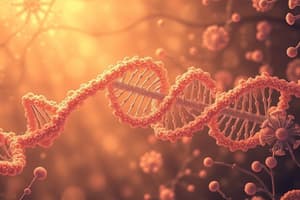Podcast
Questions and Answers
What is the primary role of ribosomal RNA (rRNA) in the cell?
What is the primary role of ribosomal RNA (rRNA) in the cell?
- Major structural component of the ribosome (correct)
- Guiding chemical modification of RNA
- Translating mRNA signals into proteins
- Interacting with small nuclear RNA
Less than 2% of the RNA transcribed from the human genome is non-coding.
Less than 2% of the RNA transcribed from the human genome is non-coding.
True (A)
What class of non-coding RNA is involved in the modification of pre-mRNA?
What class of non-coding RNA is involved in the modification of pre-mRNA?
Small nuclear RNA (snRNA)
The largest class of small non-coding RNA is __________.
The largest class of small non-coding RNA is __________.
Match the non-coding RNA with its function:
Match the non-coding RNA with its function:
What percentage of the human genome is transcribed into RNA?
What percentage of the human genome is transcribed into RNA?
Transfer RNA (tRNA) is solely responsible for coding proteins.
Transfer RNA (tRNA) is solely responsible for coding proteins.
What are the two classes of small nuclear RNA?
What are the two classes of small nuclear RNA?
What type of gene knockdown is typically associated with shRNA transfection?
What type of gene knockdown is typically associated with shRNA transfection?
SiRNA is typically used for long-term gene expression changes.
SiRNA is typically used for long-term gene expression changes.
What is a key requirement for a successful overexpression system in higher eukaryotes?
What is a key requirement for a successful overexpression system in higher eukaryotes?
Adenovirus vectors are well suited for _____ due to their ability to transduce both dividing and non-dividing cells.
Adenovirus vectors are well suited for _____ due to their ability to transduce both dividing and non-dividing cells.
Match the following vector types with their descriptions:
Match the following vector types with their descriptions:
What is the primary function of short interfering RNA (siRNA)?
What is the primary function of short interfering RNA (siRNA)?
Micro RNA (microRNA) is involved in translational repression or cleavage of target mRNAs.
Micro RNA (microRNA) is involved in translational repression or cleavage of target mRNAs.
What is the purpose of providing a homologous repair template in gene editing?
What is the purpose of providing a homologous repair template in gene editing?
Indel refers to the combination of insertion and deletion of bases in an organism's genome.
Indel refers to the combination of insertion and deletion of bases in an organism's genome.
What are the most common group of non-coding RNAs (ncRNAs) that are over 200 bases in length?
What are the most common group of non-coding RNAs (ncRNAs) that are over 200 bases in length?
LncRNAs can act as either ___________ or ___________ transcriptional regulatory elements.
LncRNAs can act as either ___________ or ___________ transcriptional regulatory elements.
What are the two main mechanisms of RNA interference?
What are the two main mechanisms of RNA interference?
CRISPR/Cas9 technology relies on __________ to create site-specific genomic modifications.
CRISPR/Cas9 technology relies on __________ to create site-specific genomic modifications.
Match the following non-coding RNAs with their primary functions:
Match the following non-coding RNAs with their primary functions:
Match the following terms to their definitions:
Match the following terms to their definitions:
Which long non-coding RNA is associated with the deactivation of X chromosome function?
Which long non-coding RNA is associated with the deactivation of X chromosome function?
Loss of regulation of LncRNAs has not been linked to human cancers.
Loss of regulation of LncRNAs has not been linked to human cancers.
Which type of RNA is produced during RNA interference?
Which type of RNA is produced during RNA interference?
Nuclease-deficient Cas9 is used to introduce double-stranded breaks in DNA.
Nuclease-deficient Cas9 is used to introduce double-stranded breaks in DNA.
What example of LncRNA has been noted for its role in cancer metastasis?
What example of LncRNA has been noted for its role in cancer metastasis?
Extracellular RNA (exRNA) is believed to be involved in ___________ and ___________ regulation.
Extracellular RNA (exRNA) is believed to be involved in ___________ and ___________ regulation.
What is the result of using two sgRNAs with mutated Cas9?
What is the result of using two sgRNAs with mutated Cas9?
The formation of a __________ is crucial for the degradation of target mRNA during RNA interference.
The formation of a __________ is crucial for the degradation of target mRNA during RNA interference.
What role do LncRNAs play in relation to oncogenes and tumor suppressor genes?
What role do LncRNAs play in relation to oncogenes and tumor suppressor genes?
What is a potential outcome of gene knockdown?
What is a potential outcome of gene knockdown?
Which technique involves the permanent deactivation of a specific gene within an organism?
Which technique involves the permanent deactivation of a specific gene within an organism?
Homologous recombination does not utilize the cell's own DNA repair mechanisms.
Homologous recombination does not utilize the cell's own DNA repair mechanisms.
What is one common method used to introduce synthetic DNA sequences into cells?
What is one common method used to introduce synthetic DNA sequences into cells?
As of 2009, approximately ______ genes had been knocked out of mice.
As of 2009, approximately ______ genes had been knocked out of mice.
Which of the following techniques is used to create engineered mutations directed to a specific locus?
Which of the following techniques is used to create engineered mutations directed to a specific locus?
Site-specific nucleases can be used to achieve gene knockouts.
Site-specific nucleases can be used to achieve gene knockouts.
What is the main purpose of gene knockdowns in research?
What is the main purpose of gene knockdowns in research?
_______ is a technology that can be used in homologous recombination to target specific genes.
_______ is a technology that can be used in homologous recombination to target specific genes.
Match the following gene delivery techniques with their descriptions:
Match the following gene delivery techniques with their descriptions:
What type of RNA accounts for a large proportion of transcribed RNA within eukaryotic cells?
What type of RNA accounts for a large proportion of transcribed RNA within eukaryotic cells?
Flashcards
Ribosomal RNA (rRNA)
Ribosomal RNA (rRNA)
A type of RNA that forms the core of ribosomes, the cellular machinery responsible for protein synthesis. rRNA interacts with mRNA during translation.
Transfer RNA (tRNA)
Transfer RNA (tRNA)
RNA molecules that transport specific amino acids to the ribosome during translation, ensuring the correct order of amino acids in the growing protein chain.
Small Nuclear RNA (snRNA)
Small Nuclear RNA (snRNA)
Non-coding RNA molecules involved in various processes within the cell, including mRNA processing and splicing.
Small Nucleolar RNA (snoRNA)
Small Nucleolar RNA (snoRNA)
Signup and view all the flashcards
Piwi-interacting RNA (piRNA)
Piwi-interacting RNA (piRNA)
Signup and view all the flashcards
Short Interfering RNA (siRNA)
Short Interfering RNA (siRNA)
Signup and view all the flashcards
Micro RNA (microRNA)
Micro RNA (microRNA)
Signup and view all the flashcards
Extracellular RNA (exRNA)
Extracellular RNA (exRNA)
Signup and view all the flashcards
Small Cajal body-specific RNA (scaRNA)
Small Cajal body-specific RNA (scaRNA)
Signup and view all the flashcards
Long Non-Coding RNA (lncRNA)
Long Non-Coding RNA (lncRNA)
Signup and view all the flashcards
Gene Knockdown
Gene Knockdown
Signup and view all the flashcards
RNA Interference
RNA Interference
Signup and view all the flashcards
CRISPR/Cas9
CRISPR/Cas9
Signup and view all the flashcards
shRNA
shRNA
Signup and view all the flashcards
siRNA
siRNA
Signup and view all the flashcards
Overexpression
Overexpression
Signup and view all the flashcards
Adenovirus Vector
Adenovirus Vector
Signup and view all the flashcards
Retroviral Vector
Retroviral Vector
Signup and view all the flashcards
Vaccinia Vector
Vaccinia Vector
Signup and view all the flashcards
Plasmid-based Vector
Plasmid-based Vector
Signup and view all the flashcards
Gene Knockout
Gene Knockout
Signup and view all the flashcards
Homologous Recombination
Homologous Recombination
Signup and view all the flashcards
Site-specific Nucleases
Site-specific Nucleases
Signup and view all the flashcards
Gene Expression Profiling
Gene Expression Profiling
Signup and view all the flashcards
Overexpression and Gene Knockout/Knockdown
Overexpression and Gene Knockout/Knockdown
Signup and view all the flashcards
Study Notes
RNA Overview
- RNA plays a crucial role in the central dogma of molecular biology.
- Over 75% of the human genome is transcribed to RNA, but less than 2% encodes proteins.
- The remaining RNA consists of non-coding transcripts.
Non-Coding RNA (ncRNA) Classification
- Ribosomal RNA (rRNA): Major component of ribosomes; interacts with mRNA.
- Transfer RNA (tRNA): Facilitates translation of mRNA into proteins.
- Small Nuclear RNA (snRNA): Involved in pre-mRNA modification; includes smRNA and lsmRNA.
- Small Nucleolar RNA (snoRNA): Guides modifications of other RNA molecules.
- Piwi-interacting RNA (piRNA): Largest class of small ncRNA; involved in gene silencing in germlines.
- Short Interfering RNA (siRNA): Silences genes by degrading RNAs from viruses and repetitive sequences.
- Micro RNA (microRNA): Regulates gene silencing through mRNA cleavage.
- Extracellular RNA (exRNA): Participates in cell-cell communication and regulation.
- Small Cajal body-specific RNA (scaRNA): Regulates RNA polymerase II activities within Cajal bodies.
Long Non-Coding RNA (LncRNA)
- Defined as non-coding RNAs over 200 bases long, regulating gene expression and protein function.
- Act as transcriptional regulatory elements, either enhancing or repressing transcription.
- Example: Xist deactivates the X chromosome by interacting with polycomb-repressive complexes.
- Changes in LncRNA regulation link to human cancers, with overexpression of HOTAIR associated with metastasis and tumorigenesis.
Gene Manipulation Techniques
- Gene Knockdown: Alters gene expression, reducing protein levels significantly without complete deactivation; can be temporary or permanent.
- RNA Interference: Transient gene knockdown via anti-sense RNA production, employing siRNA or shRNA mechanisms leading to mRNA degradation.
- CRISPR/Cas9: Allows precise genome editing by introducing specific nicks or fusions for targeted gene modification.
Laboratory Applications
- Investigating gene expression profiles helps understand cell signaling mechanisms.
- Overexpression and gene knockout/knockdown methods are essential for studying signaling pathways.
Gene Knockout Techniques
- Permanent gene deactivation with methods like homologous recombination and site-specific nucleases.
- Homologous recombination has successfully knocked out approximately 11,000 genes in mice, equating to half the mouse genome.
shRNA vs siRNA
- shRNA generally enables stable, long-term gene knockdown, while siRNA typically leads to transient gene silencing.
Overexpression Systems
- Employed predominantly in mammalian cells using immortalized cell lines and suitable vectors to produce protein overexpression.
- Common vector types:
- Adenovirus Vectors: High transgene expression in dividing and non-dividing cells, carrying up to 8.5 kb of DNA.
- Retroviral Vectors: RNA viruses replicating via a dsDNA intermediate, including lentiviruses.
- Vaccinia Vectors: Double-stranded DNA viruses replicating in the host cell cytoplasm.
- Plasmid-based Vectors: Common in recombinant DNA technology for protein expression.
Studying That Suits You
Use AI to generate personalized quizzes and flashcards to suit your learning preferences.




